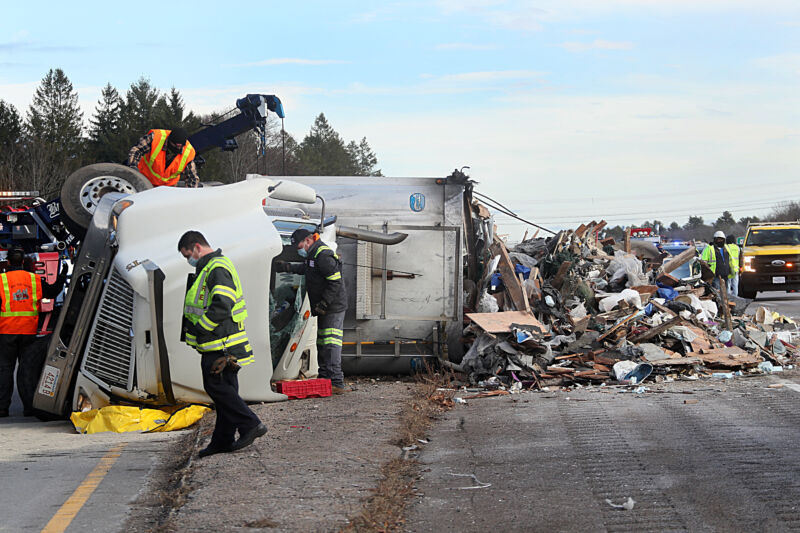Progress —
Urban pedestrian and cyclist deaths have risen over the last decade.
Timothy B. Lee
–

Enlarge / A truck on Route 93 in Canton, MA, rolled over on Dec. 7, 2020.
Motor vehicle traffic crashes killed 36,096 people in 2019, according to new data from the National Highway Traffic Safety Administration (NHTSA). That’s a 2 percent decline from the 2018 figure and a continuation of a decades-long trend toward safer roads.
Traffic fatalities peaked in the late 1970s, with more than 50,000 people dying per year. Since then, annual deaths have generally been trending downwards.
Progress on road safety saw a brief reversal between 2014 and 2016, when fatalities rose from 32,744 to 37,806. But since then, the figure has declined three years in a row—though it’s still not below the record lows of the early 2010s.
Progress has been even more dramatic when you factor in America’s rising population and miles traveled. Fatalities per 100 million miles of driving fell from 3.35 in 1975 to 1.10 in 2019.
As I wrote a couple of years ago, a number of factors have contributed to the long-term trend toward safer roads, including cars engineered for better crash-worthiness, increasing use of seat belts and airbags, and stricter enforcement of drunk-driving laws. In the 1970s, 60 percent of traffic fatalities in the United States involved alcohol use. In 2019, it was less than 30 percent.
Pedestrians and cyclists at risk
While the news is good overall, the latest NHTSA report does highlight a few areas of concern. The overall number of injured people ticked up slightly, from 2.71 percent in 2018 to 2.74 percent in 2019.
The NHTSA says that 3,142 people died as a result of distracted driving—a 10 percent increase over the 2018 figure of 2,858. However, it’s not clear if there’s a long-term trend here. For example, 3,263 deaths in 2015 were attributed to distracted driving.
Over the last decade, rural highways have gotten safer while urban streets have gotten more dangerous. Rural highway deaths fell from 18,089 in 2010 to 16,340 in 2019 as rural miles traveled stayed flat. By contrast, urban roadway deaths increased by 34 percent as urban miles traveled increased only 15 percent.
That’s partly because significantly more pedestrians and cyclists have died on urban roadways. “Pedestrian fatalities in urban areas increased by 62 percent since 2010,” NHTSA says, while they fell by 5 percent in rural areas. Similarly, urban cyclist fatalities rose by 49 percent between 2010 and 2019, while declining by almost 5 percent in rural areas.
This may partly reflect the growing popularity of bicycle commuting and walkable urban neighborhoods—NHTSA’s report doesn’t estimate how the numbers of urban pedestrians and cyclists on the road have changed since 2010.
In any event, there’s reason to hope that better automatic emergency braking technology could help reduce deaths among pedestrians and bicyclists in the coming years. Many cars today have AEB features, but many aren’t sophisticated enough to detect pedestrians and bicyclists. A new generation of AEB systems equipped with lidar sensors could greatly improve these systems over the next five years.

